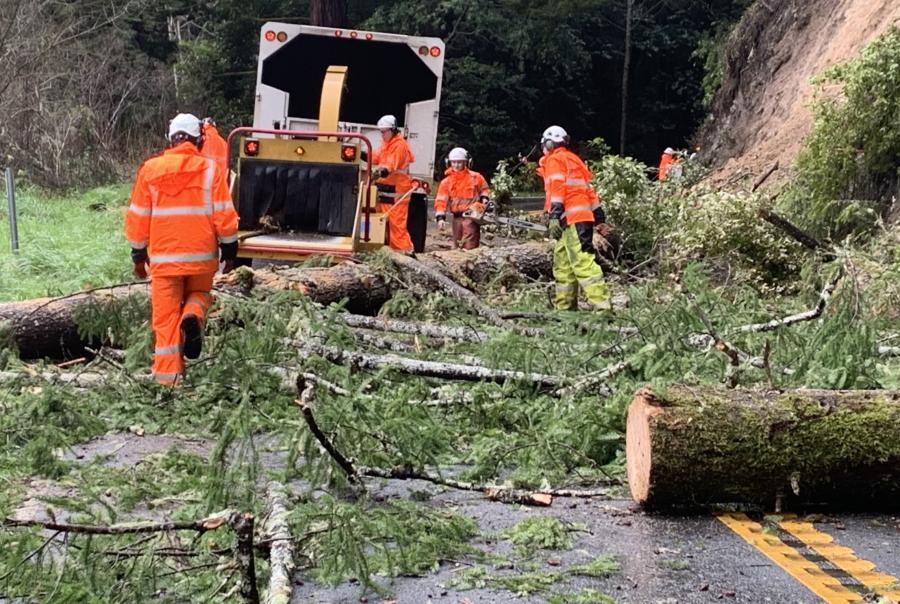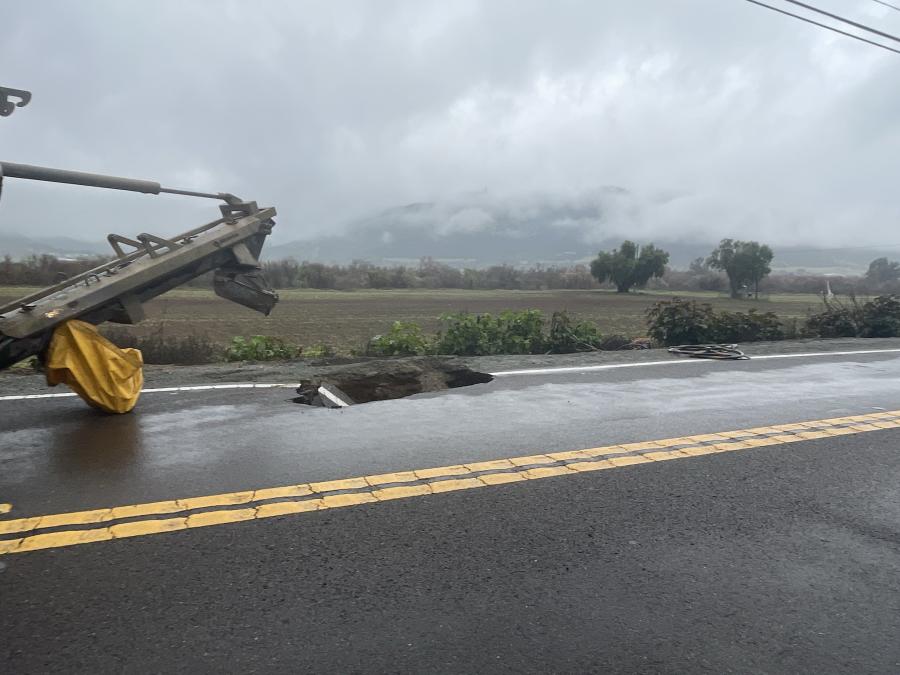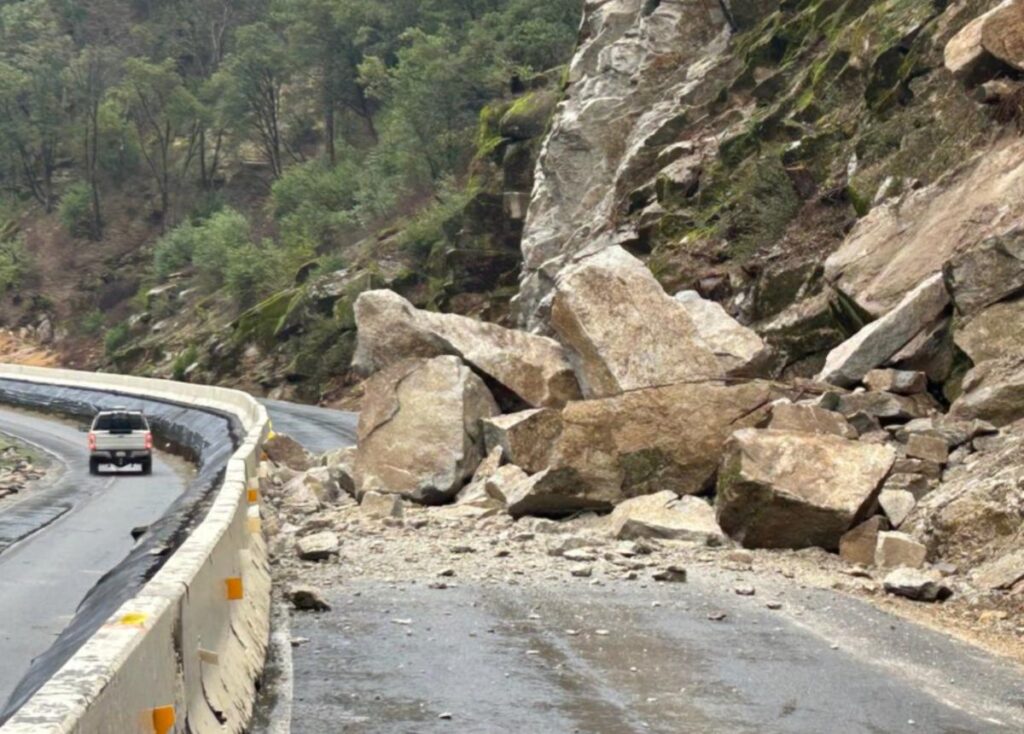Photo courtesy of Caltrans
The record-breaking rainfalls in early February for some part of the state led to states of emergency being declared in many counties in Southern California.
California was hit by two atmospheric river storms in early February that caused extensive flooding, intense winds and power outages to many regions of California, ranging from San Diego to San Francisco and the Bay Area, and as far inland as Death Valley. The record-breaking rainfalls for some part of the state led to states of emergency being declared in many counties in Southern California.

Photo courtesy of Caltrans
The powerful storms impacted the California Department of Transportation’s (Caltrans) network of roads, leading to landslides and mudslides, washed out roads and roads that were blocked by large amounts of debris.
In San Francisco, wind gusts of hurricane force were recorded, along with wind gusts of more than 100 miles-per-hour in the Sierra Nevada. The storms not only caused landslides, but led to many rivers overflowing. Prior to the storms hitting the state, meteorologist Reed Timmer predicted that “Biblical flooding” was a real possibility.
The first Pineapple Express storm hit between February 1 to 2, which crossed the mountains and subsequently settled over the I-25 corridor in Colorado.
The next storm hit on February 4 with such force that the National Weather Service categorized it as “potentially life-threatening”, and led to Los Angeles County declaring a state of emergency.
Crews On Scene
As powerful and dangerous as the storms were, Caltrans personnel were up for the challenge and crews performed sterling work in the midst of severe weather.
“Caltrans has repaired about 1,100 potholes in Ventura and Los Angeles counties between Feb. 1 and Feb. 8,” said Comeaux. “During the storm, Caltrans maintenance crews were on 12-hour shifts, 24 hours a day. They were ready with pumps, generators and other equipment to respond to any incidents, and they ensured reflective signs were available for traffic control needs in the event of power outages. This preparation helped crews respond to flooded highways and clear mudslides to reopen the highway back to motorists. Caltrans District 7 informed the public by posting to social media pages like Twitter/X and Instagram about closures and advising motorists not to travel due to severe winter storm event.”
District 7 experts are still assessing the damage and preparing reports to help establish an emergency repair plan that will be executed by general contractors hired for the work.
Hayden Manning, a PIO with District 11 (San Diego and Imperial counties), updated the situation and how Caltrans prepared for the arrival of the storms.
“These storms may have been the most challenging and impactful storms of the year,” he said. “While Caltrans performs maintenance year-round, these efforts are ramped up prior to weather events. State maintained culverts and drainage facilities were inspected and cleared ahead of the storm to prevent flooding. While roadway flooding was minimal, some residential areas near our facilities experienced flood conditions due to the limited capacity of the municipal infrastructure. The cities and County are working within the State of Emergency guidelines to remediate damages.”
Rick Brewer, a media manager of Caltrans HQ, provided a state-wide context of the emergency and the overall response.
“During the peak of the storms, Caltrans had more than 4,000 maintenance personnel working to keep the highways and interstates open and safe,” he said. “That included removing snow, ice, fallen trees, and debris from the roadways and culverts. In some cases, where situations force a highway or interstate to be partially or fully closed, Caltrans also hires contractors to perform emergency restorative projects so our crews can continue working to keep the rest of the state highways system functioning at its optimum levels.”

Photo courtesy of Caltrans
Caltrans has utilized 1,200 pieces of heavy equipment for emergency operations. At its peak, there were 69 road closures throughout the state, of which 59 had been reopened by Feb. 8. The current estimate of the damage to the state highway system is $40.1 million.
Comeaux provided an update on the situation regarding major roads. He noted that the southbound I-5 connector to southbound I-110 and the section of State Route 27 (Topanga Canyon Boulevard) that was closed from Oakwood Drive to Old Topanga Canyon Road, are now open to traffic
State Route 33 north of the city of Ojai (between Fairview Road and Lockwood Valley Road) has reopened to traffic following the removal of a mudslide that occurred during these storms and temporarily blocked all lanes.
“Nevertheless, State Route 33 between Fairview Road and Lockwood Valley Road has five locations where repairs from 2023 [last year’s)winter storms are still being constructed,” said Comeaux, “and at each of the five locations, only one lane is available. It is being used by traffic in both directions on an alternating basis.”
February 6 was a bad day for highways and roads.
“As of February 6 the rain falls brought more than 300 landslides and severe flash flooding throughout the state,” according to Wikipedia. “San Diego received record rainfall for California at higher elevations causing floods and prompting road closures. A tornado warning would be issued for portions of San Diego County by the National Weather Service due to a severe thunderstorm produced by the storm complex, although no damage would be caused.”
On Feb. 7, it was noted that Death Valley received 1.66 in. of rain in 72 hours, which led to SR 190 being closed.
Caltrans District 7, on February 6, issued a press release on the impacts of the storm and road closures in Los Angeles and Ventura counties, and updates on the clean up and repair work. The following descriptions of road closures provide a vivid description of what Caltrans was experiencing:
State Route 1 (Pacific Coast Highway) in both directions between Las Posas Road and Sycamore Canyon Road in Ventura County will close overnight due to high tides and potential nighttime visibility issues after a right lane shoulder was partially washed out from storm-related erosion. The roadway is scheduled to open daily and close nightly through at least Saturday, unless there is additional erosion.
The southbound I-5 to southbound I-110 connector is closed due to multiple mudslides. The right lane on southbound I-5 at Stadium Way is also closed. Unknown duration.
State Route 27 (Topanga Canyon Boulevard) is closed from Oakwood Drive to Old Topanga Canyon Road due to flooding and mudslides from overflow of Topanga Creek. Unknown duration
Mudslides are blocking lanes on State Route 33 north of Ojai. SR-33 is closed in both directions between Fairview Road and Lockwood Valley Road. Unknown duration.
The far-right lane on westbound I-210 between Hubbard and Roxford streets in Sylmar is currently closed due to a sinkhole off the side of the highway. Unknown duration. CEG
Read the full article here











